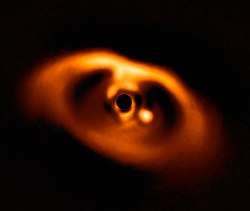Fulton gap
The Fulton gap (also called the photoevaporation valley[1][2] or Sub-Neptune Desert[3]) is an observed scarcity of planets with radii between 1.5 and 2 times Earth's radius, likely due to photoevaporation-driven mass loss.[4][5][6] A bimodality in the Kepler exoplanet population was first observed in 2013, and was noted as possibly confirming an emerging hypothesis that photoevaporation could drive atmospheric mass loss on close-in, low-mass planets.[4][7] This would lead to a population of bare, rocky cores with smaller radii at small separations from their parent stars, and planets with thick hydrogen- and helium-dominated envelopes with larger radii at larger separations.[4][7] The bimodality in the distribution was confirmed with higher-precision data in the California-Kepler Survey in 2017,[5][8] which was shown to match the predictions of the photoevaporative mass-loss hypothesis later that year.[6]
Despite the implication of the word 'gap', the Fulton gap does not actually represent a range of radii completely absent from the observed exoplanet population, but rather a range of radii that appear to be relatively uncommon[5]. As a result, 'valley' is often used in place of 'gap'.[1][2][6] The specific term "Fulton gap" is named for Benjamin J. Fulton, whose doctoral thesis included precision radius measurements that confirmed the scarcity of planets between 1.5 and 2 Earth radii, for which he won the Robert J. Trumpler Award,[9][10] although the existence of this radius gap had been noted along with its underlying mechanisms as early as 2012[7] and 2013.[4]
Possible explanations
See also
References
- Van Eylen, V; Agentoft, Camilla; Lundkvist, M S; Kjeldsen, H; Owen, J E; Fulton, B J; Petigura, E; Snellen, I (2018-07-06). "An asteroseismic view of the radius valley: stripped cores, not born rocky". Monthly Notices of the Royal Astronomical Society. Oxford University Press (OUP). 479 (4): 4786–4795. doi:10.1093/mnras/sty1783. ISSN 0035-8711.
- Armstrong, David J.; Meru, Farzana; Bayliss, Daniel; Kennedy, Grant M.; Veras, Dimitri (2019-07-17). "A Gap in the Mass Distribution for Warm Neptune and Terrestrial Planets". The Astrophysical Journal. American Astronomical Society. 880 (1): L1. doi:10.3847/2041-8213/ab2ba2. ISSN 2041-8213.
- McDonald, George D.; Kreidberg, Laura; Lopez, Eric (2019-04-29). "The Sub-Neptune Desert and Its Dependence on Stellar Type: Controlled by Lifetime X-Ray Irradiation". The Astrophysical Journal. American Astronomical Society. 876 (1): 22. doi:10.3847/1538-4357/ab1095. ISSN 1538-4357.
- Owen, James E.; Wu, Yanqin (2013-09-12). "KEPLERPLANETS: A TALE OF EVAPORATION". The Astrophysical Journal. IOP Publishing. 775 (2): 105. doi:10.1088/0004-637x/775/2/105. ISSN 0004-637X.
- Fulton, Benjamin J.; Petigura, Erik A.; Howard, Andrew W.; Isaacson, Howard; Marcy, Geoffrey W.; Cargile, Phillip A.; Hebb, Leslie; Weiss, Lauren M.; Johnson, John Asher; Morton, Timothy D.; Sinukoff, Evan; Crossfield, Ian J. M.; Hirsch, Lea A. (2017-08-24). "The California-KeplerSurvey. III. A Gap in the Radius Distribution of Small Planets". The Astronomical Journal. American Astronomical Society. 154 (3): 109. doi:10.3847/1538-3881/aa80eb. ISSN 1538-3881.
- Owen, James E.; Wu, Yanqin (2017-09-20). "The Evaporation Valley in the Kepler Planets". The Astrophysical Journal. American Astronomical Society. 847 (1): 29. doi:10.3847/1538-4357/aa890a. ISSN 1538-4357.
- Lopez, Eric D.; Fortney, Jonathan J.; Miller, Neil (2012-11-21). "HOW THERMAL EVOLUTION AND MASS-LOSS SCULPT POPULATIONS OF SUPER-EARTHS AND SUB-NEPTUNES: APPLICATION TO THE KEPLER-11 SYSTEM AND BEYOND". The Astrophysical Journal. IOP Publishing. 761 (1): 59. doi:10.1088/0004-637x/761/1/59. ISSN 0004-637X.
- "As Planet Discoveries Pile Up, a Gap Appears in the Pattern". Quanta Magazine. 2019-05-16. Retrieved 2020-06-24.
- "BJ Fulton Wins 2018 Robert J. Trumpler Award for 'Landmark' Exoplanet Discovery Using Keck Observatory". W.M. Keck Observatory. 2018-09-10. Retrieved 2018-09-11.
- "IfA graduate receives prestigious award for work on extrasolar planets". University of Hawaiʻi System News. 2018-08-15. Retrieved 2018-09-11.
- Venturini, Julia; Helled, Ravit (17 October 2017). "The Formation of Mini-Neptunes". The Astrophysical Journal. 848 (2): 95. arXiv:1709.04736. Bibcode:2017ApJ...848...95V. doi:10.3847/1538-4357/aa8cd0.
- Mousis, Olivier; Deleuil, Magali; Aguichine, Artyom; Marcq, Emmanuel; Naar, Joseph; Lorena Acuña Aguirre; Brugger, Bastien; Goncalves, Thomas (2020). "Irradiated ocean planets bridge super-Earth and sub-Neptune populations". arXiv:2002.05243 [astro-ph.EP].
External links
- Fulton, Benjamin J.; Petigura, Erik A.; Howard, Andrew W.; Isaacson, Howard; Marcy, Geoffrey W.; Cargile, Phillip A.; Hebb, Leslie; Weiss, Lauren M.; Johnson, John Asher; Morton, Timothy D.; Sinukoff, Evan; Crossfield, Ian J. M.; Hirsch, Lea A. (2017-08-24). "The California-Kepler Survey. III. A Gap in the Radius Distribution of Small Planets". The Astronomical Journal. 154 (3): 109. arXiv:1703.10375. Bibcode:2017AJ....154..109F. doi:10.3847/1538-3881/aa80eb. ISSN 1538-3881.
